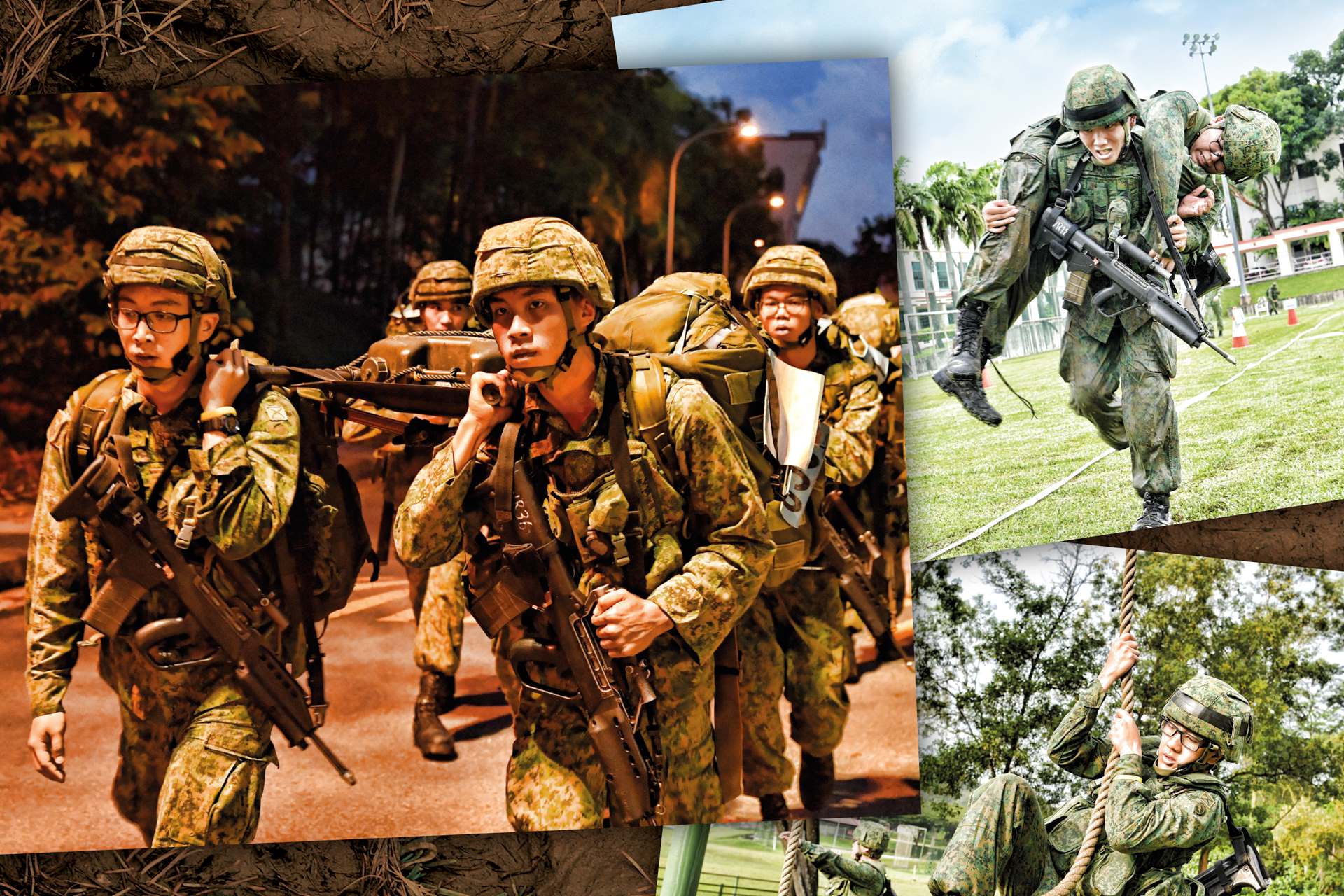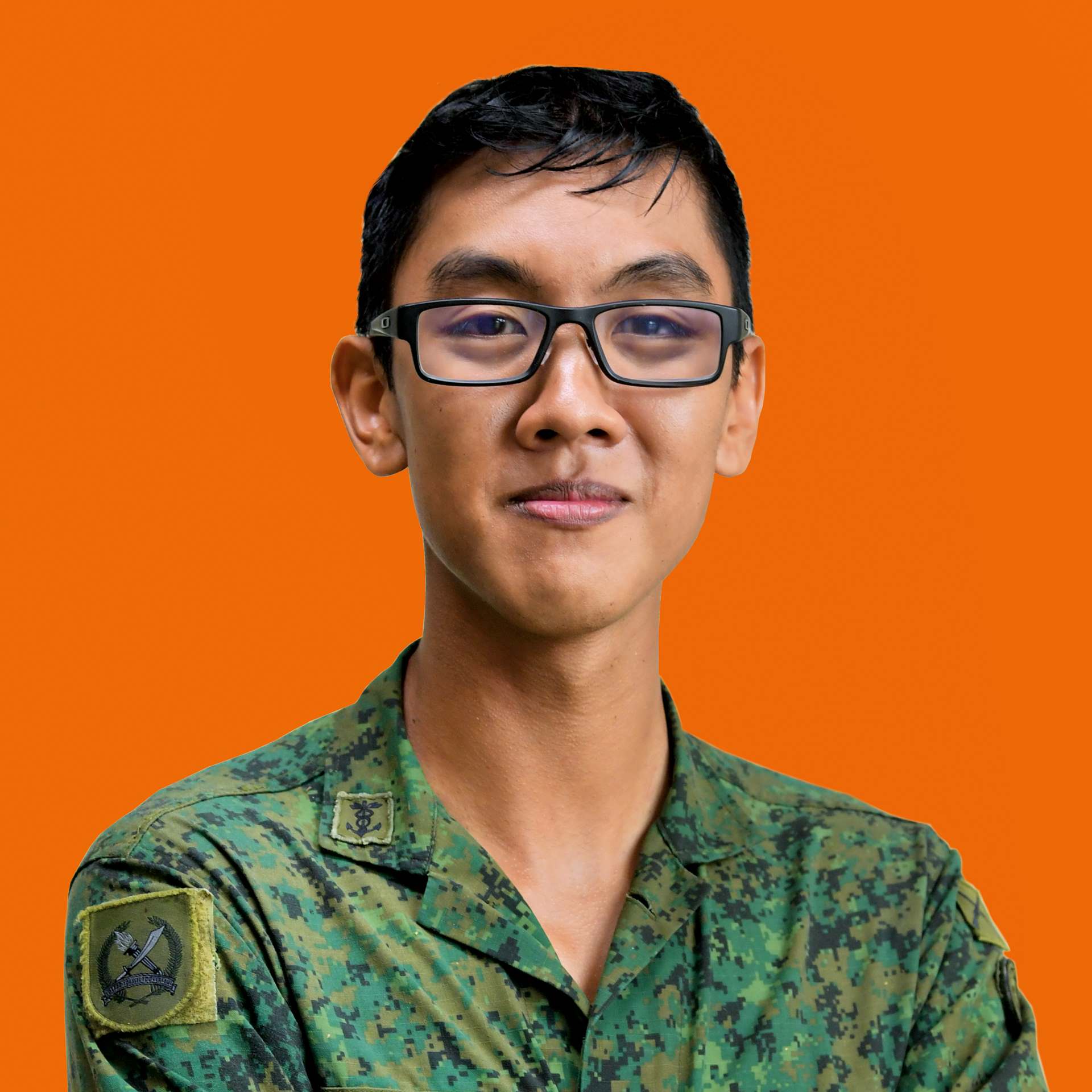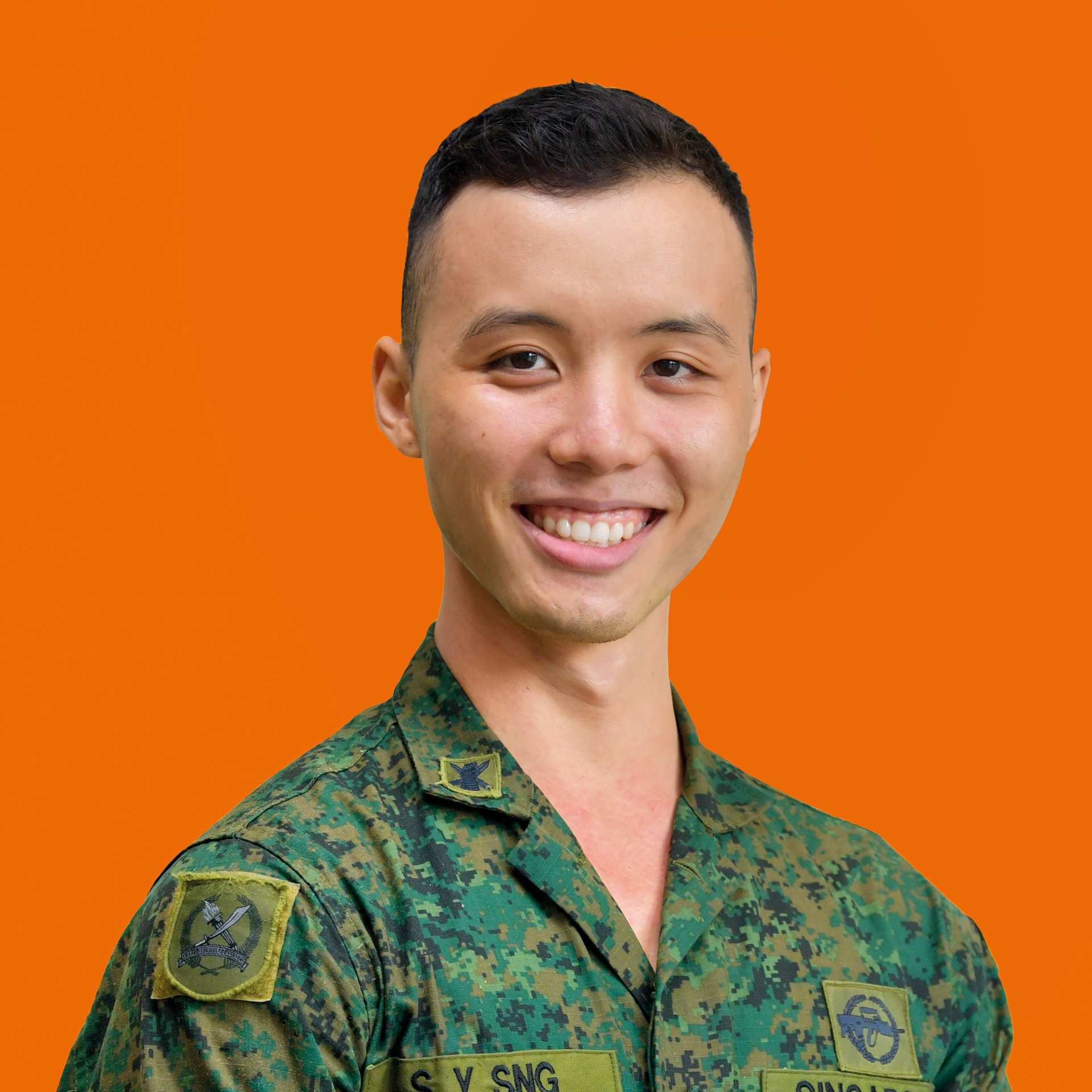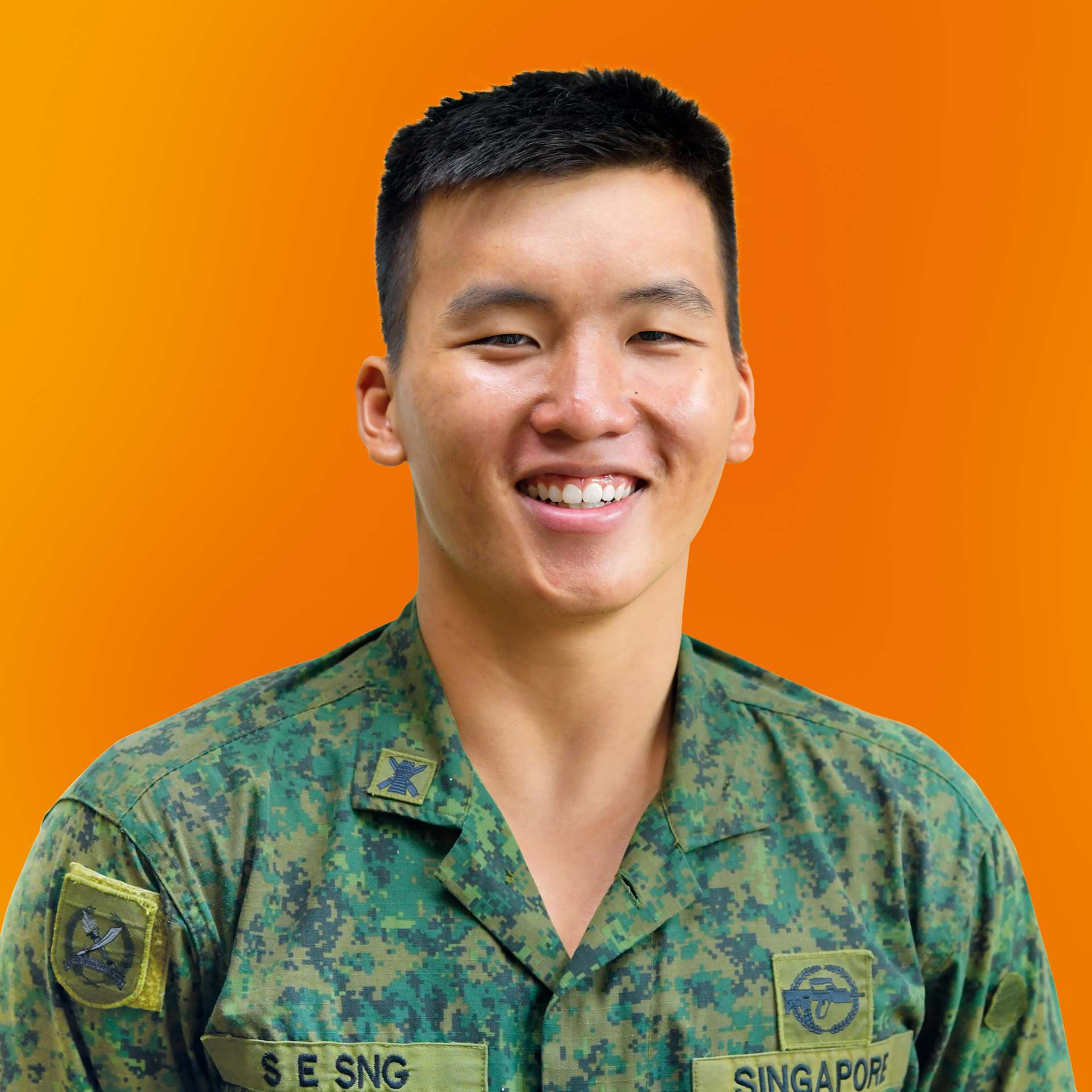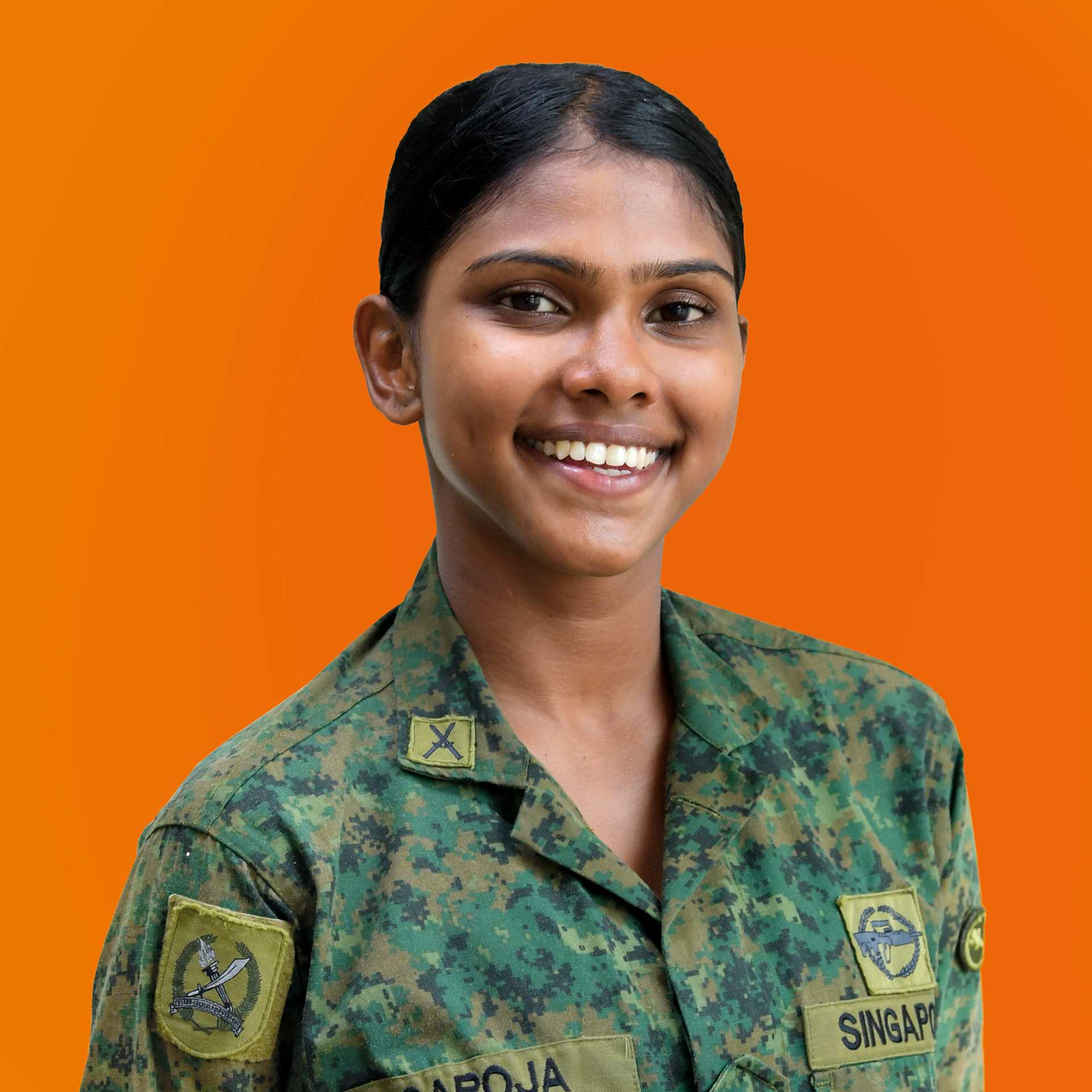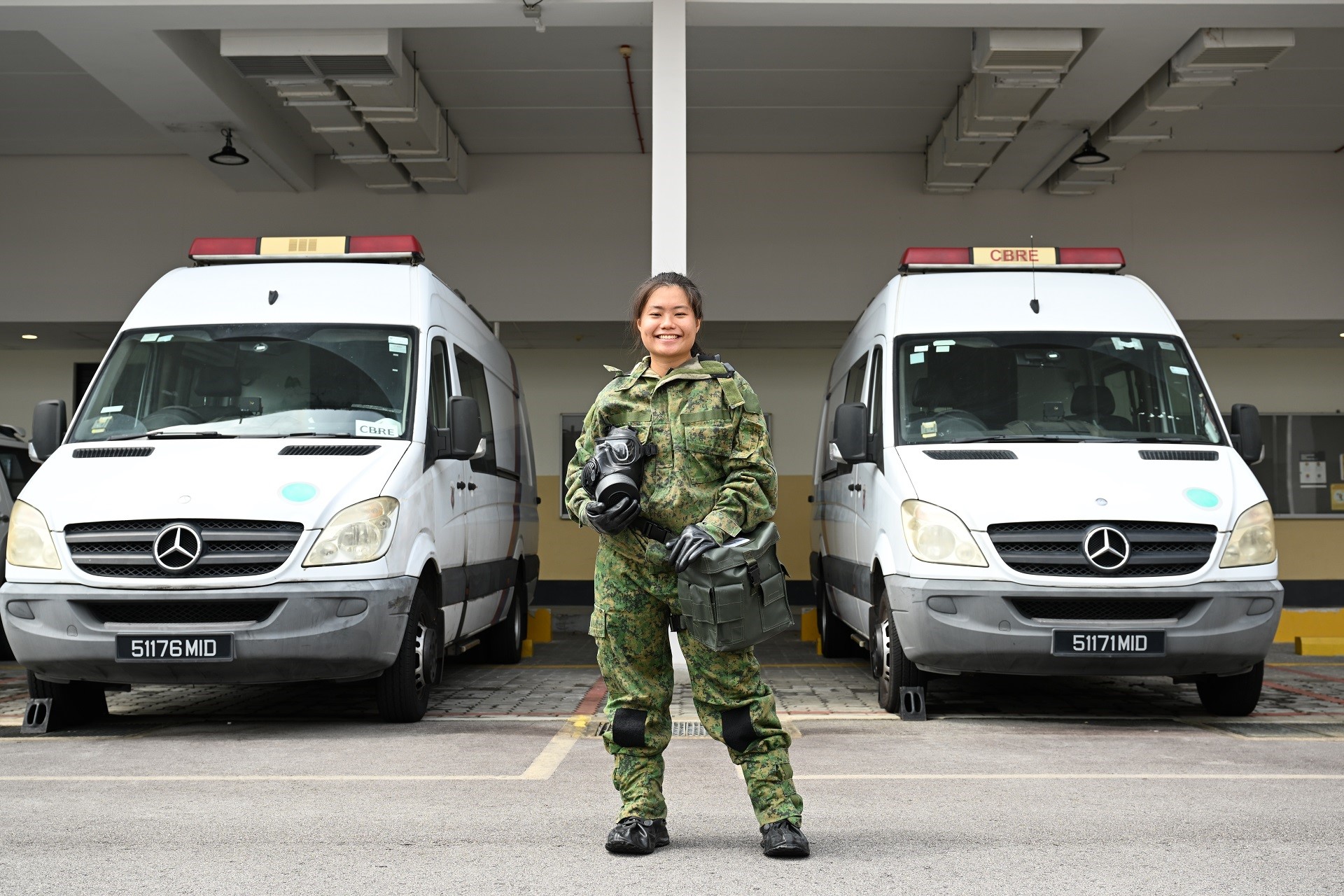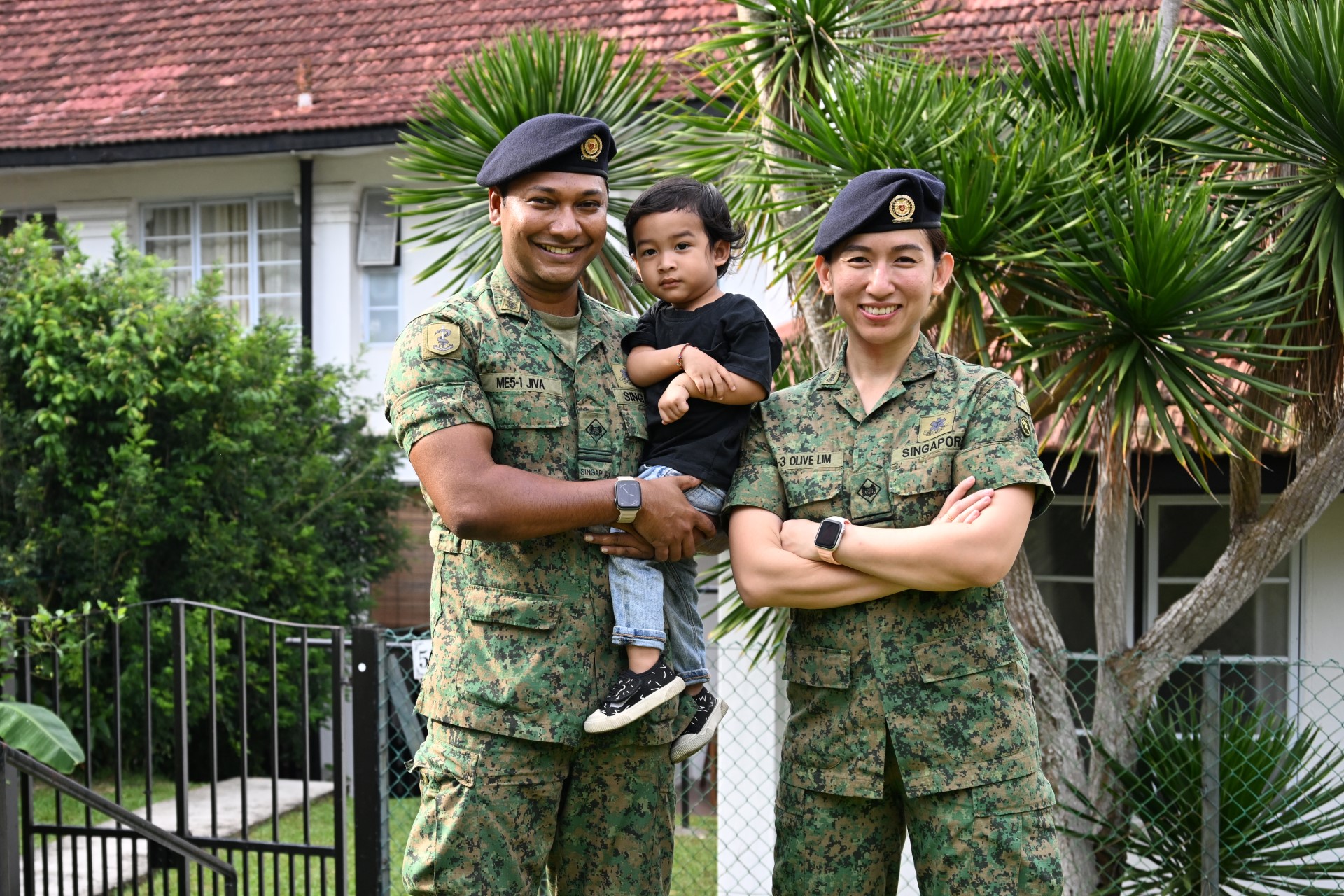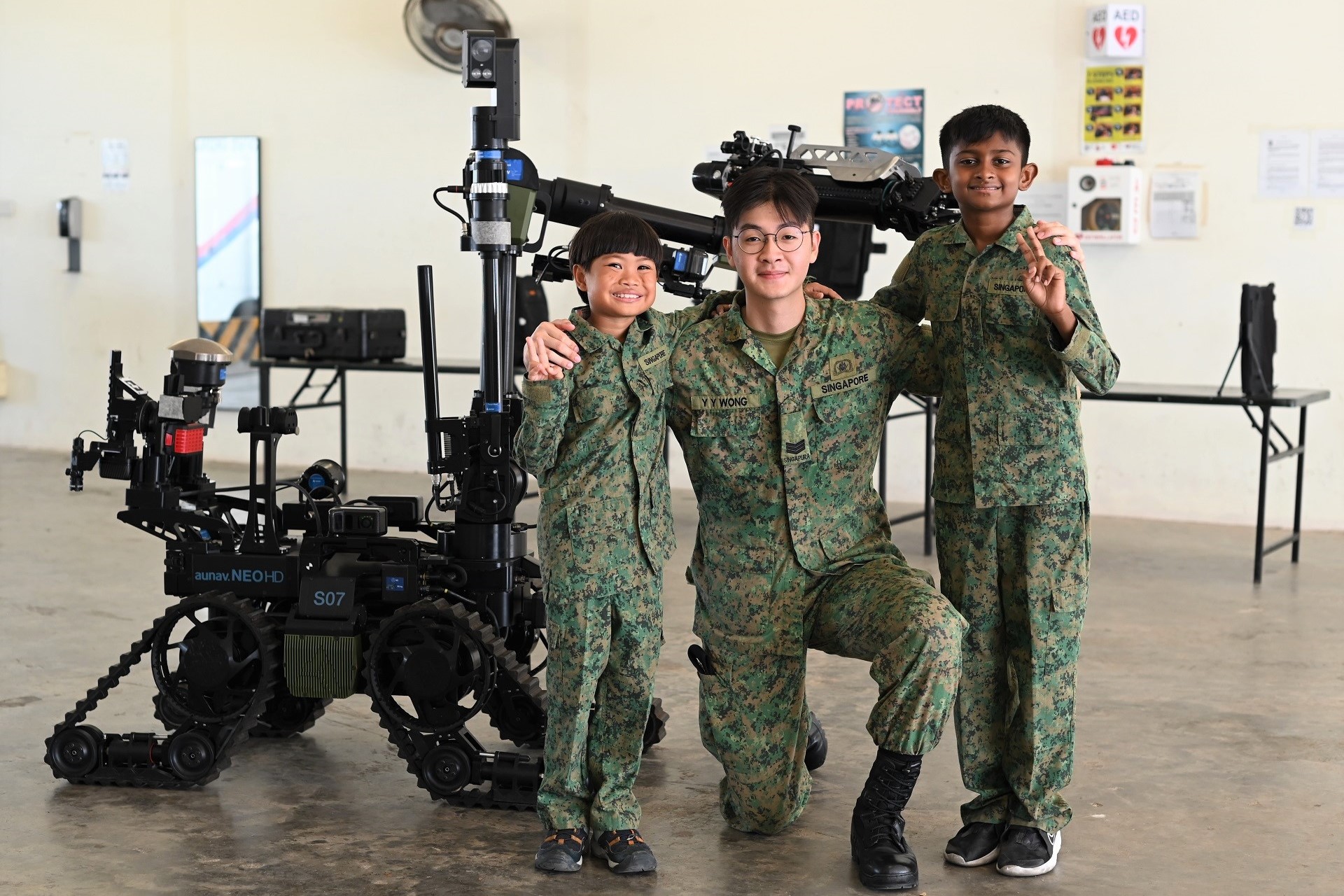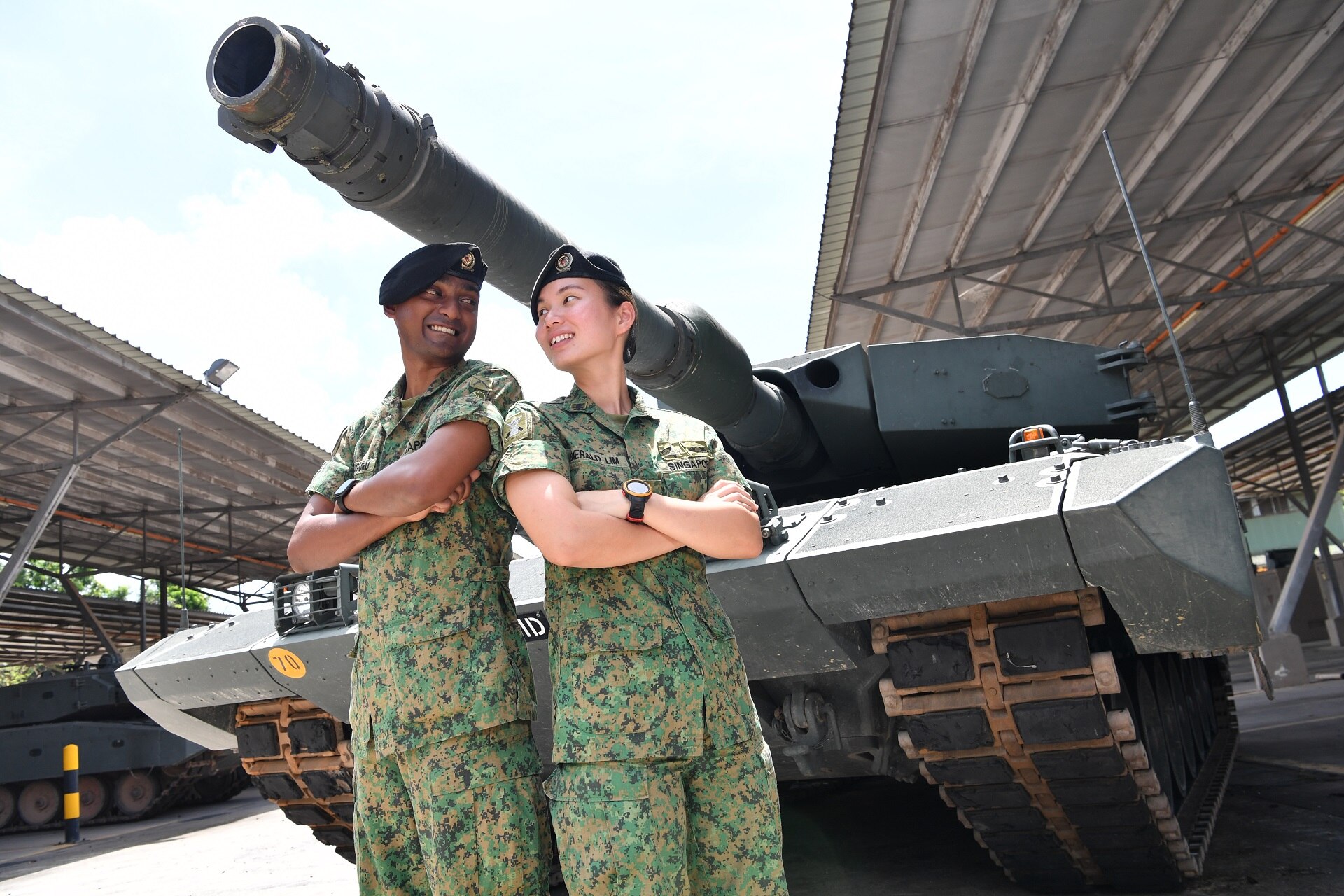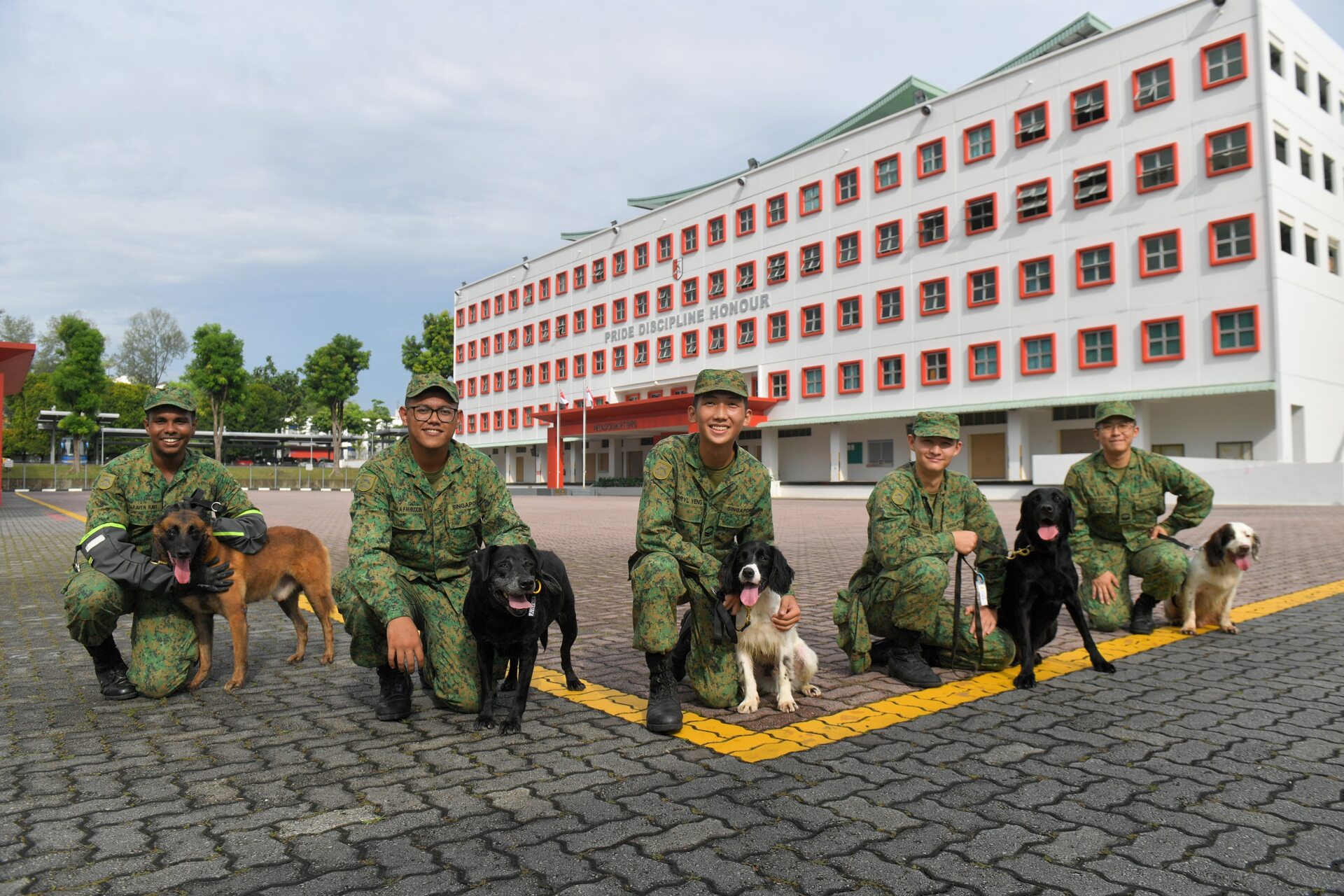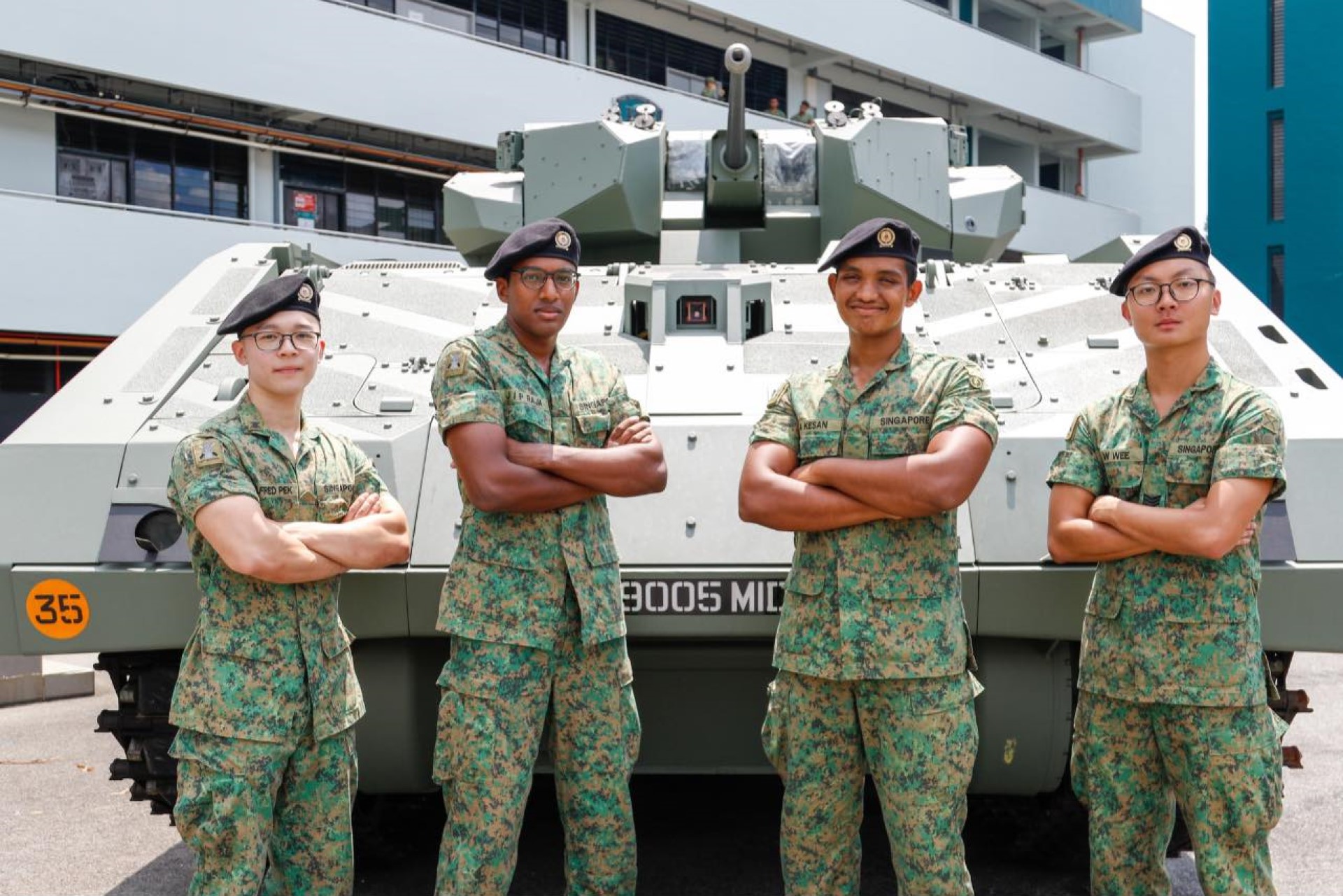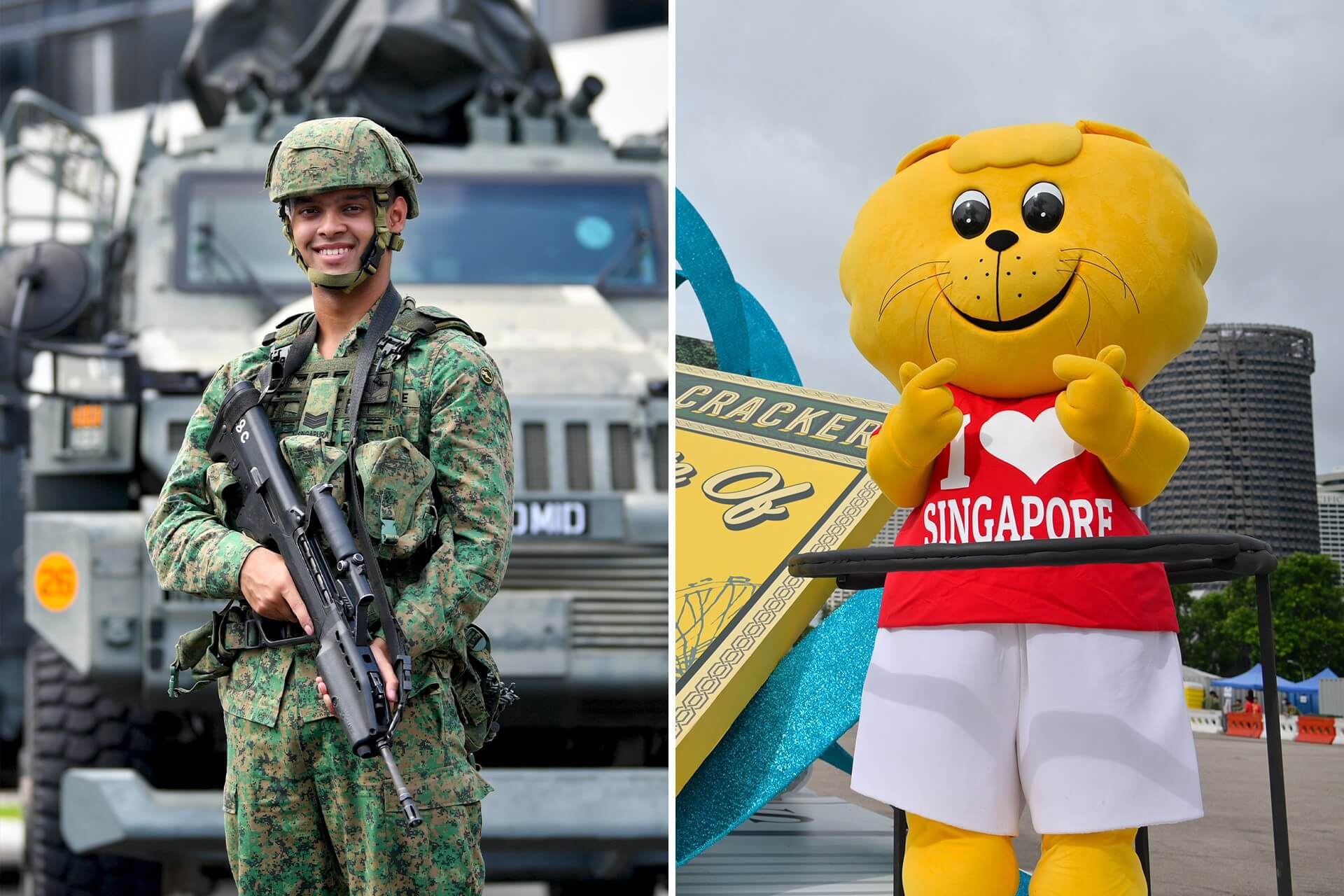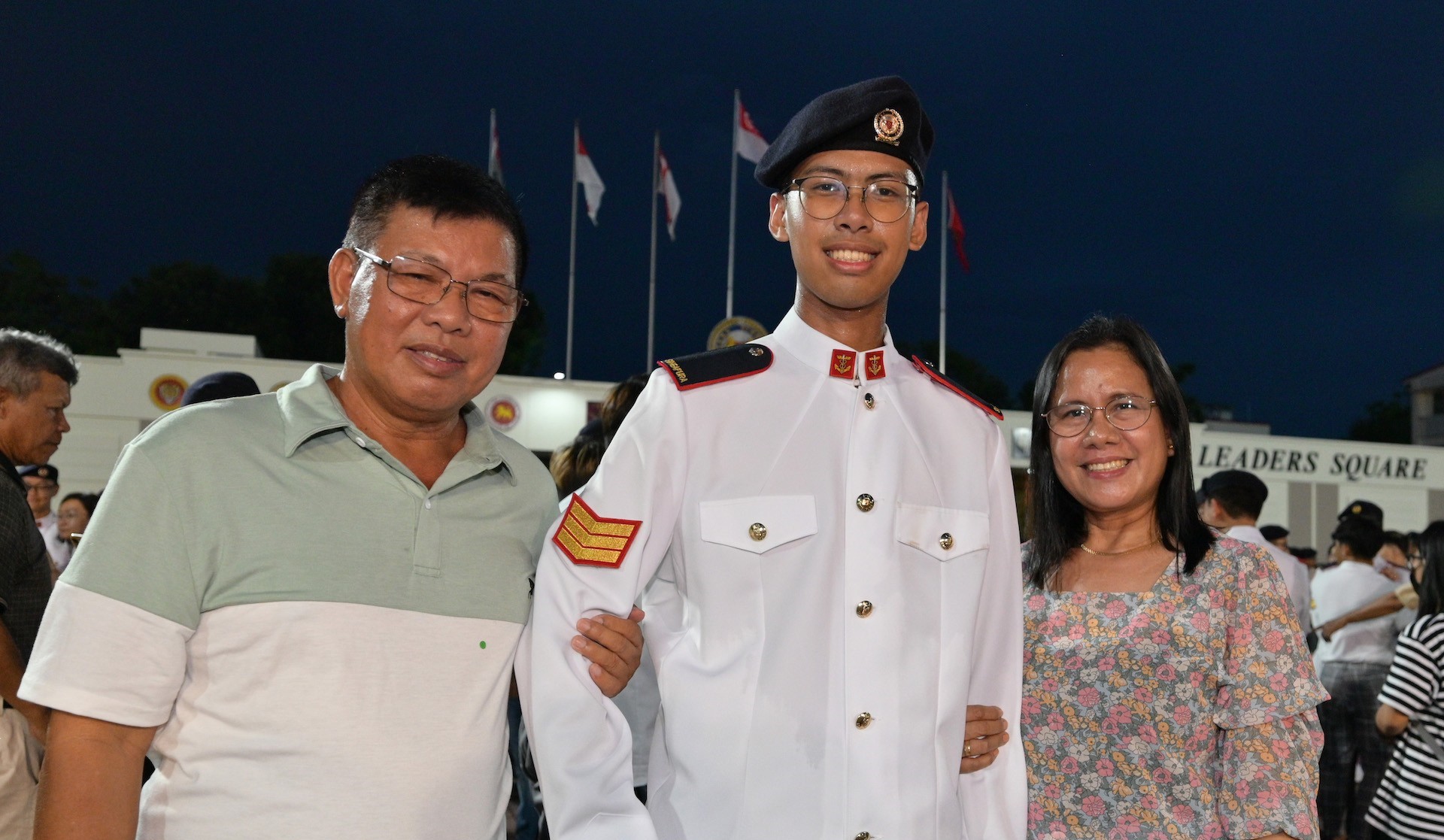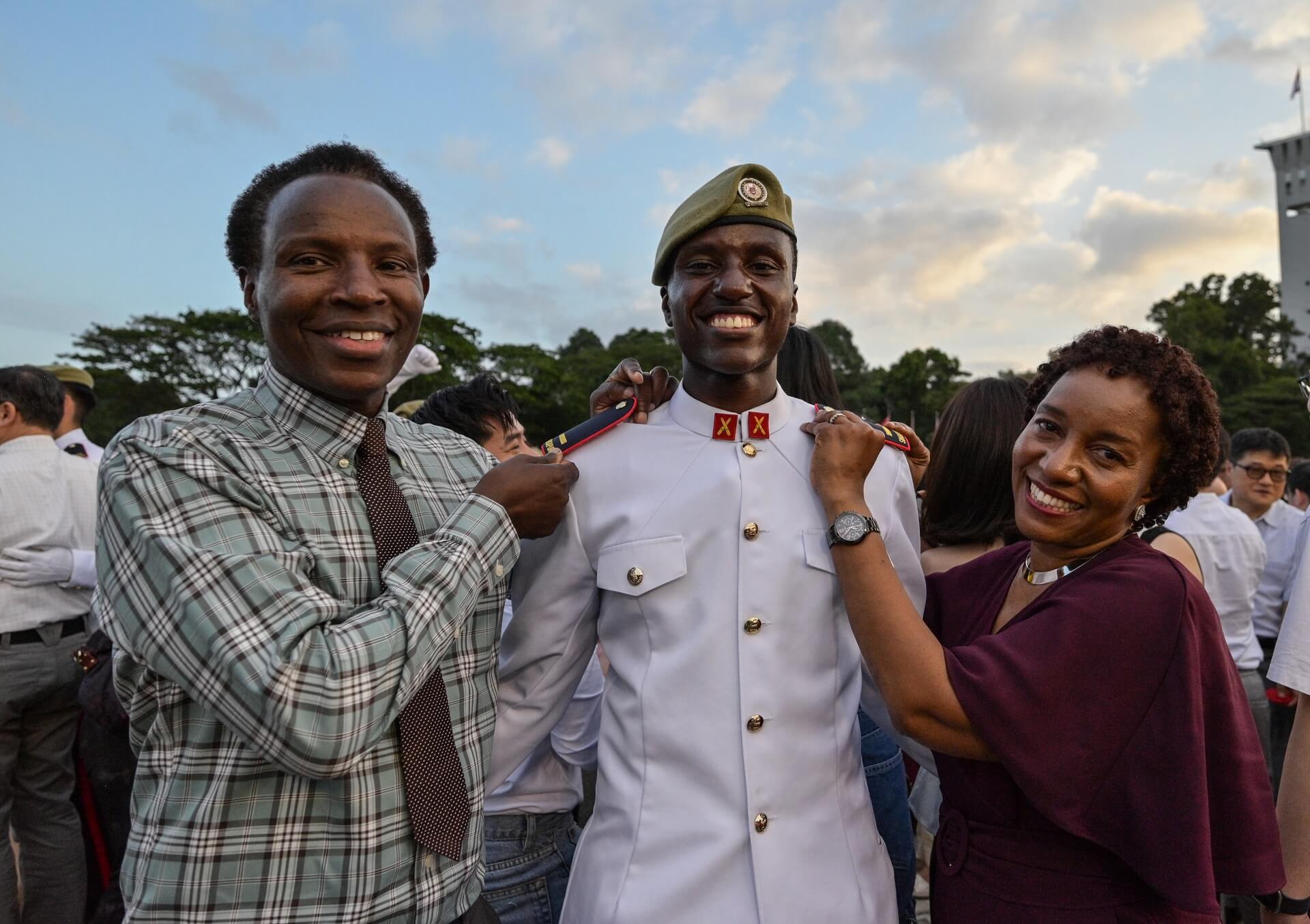P.S. We are warriors
What does it take to be a platoon sergeant? Here’s a peek into one of the toughest courses in the Singapore Army.// STORY Teo Jing Ting
// PHOTOS PIONEER photographers
It was the break of dawn. While most Singaporeans were just getting out of bed, there was already a flurry of activity at the Specialist and Warrant Officer Advanced School (SWAS) in Pasir Laba Camp.
Decked in skeletal battle order, the soldiers were each loading a filled jerry can weighing 20kg into their field packs. The route march had barely started but beads of perspiration were already rolling down their faces.
Minutes later, they heaved their field packs onto their backs. With a load of 40kg (full battle order with additional weight from the jerry can), they began the first task of the day — the 2km fast march.
The journey begins
Welcome to the Basic Warfighter-Platoon Sergeant (BWF-PS) Course. Conducted four times a year, this 11-week course equips specialists with warfighting skills and leadership qualities before they take on the role of platoon sergeants.
Apart from building up their mental and physical resilience, the course also teaches soldiers to train and instruct their men in fundamentals such as small arms handling and jungle survival.
This is done through four modules: small arms coaching course, physical training commander course, Jungle Confidence Course (JCC) and the Singapore Armed Forces (SAF) instructor course.
On 28 May, 33 specialists across various Army formations reported for the 22nd BWF-PS course at SWAS. They were split into four tangos or teams, which they would stay in throughout the course.
First test
Lifting her field pack, 3rd Sergeant (3SG) Saroja d/o Nedunjezhian felt her knees almost buckle. The load was only 8kg lighter than her 48kg frame.
But the 25-year-old section commander from 5th Battalion, Singapore Infantry Regiment (5 SIR) gritted her teeth and pushed on. After all, the 2km march was just the beginning of the Individual Skill at Arms (ISAA) module.
Once the march was done, the soldiers removed the jerry can from their field packs and moved on to the other seven stations. They consisted of an individual marksmanship test, a three-metre high platform jump and 50m swim in combat uniform, the standard obstacle course (SOC), navigation, individual field craft, fitness and weapon stations.
The ISAA pushes soldiers to their limits so that they can endure and keep a clear mind under the most strenuous of conditions, said course commander 1st Warrant Officer (1WO) Barry Peh.
The 38-year-old explained: "Being confident in combat, skilled in handling weapons and above all, having resilience is important so that when they lead their men, they are able to lead by example."
3SG Saroja was not the only one who struggled with the load. Military Expert (ME) 1 Azmi Bin Aziz, too, was trailing behind.
"It was quite demoralising. This was only the first station and I was already behind," said the 23-year-old senior instructor in the emergency medical technicians course from the SAF Medical Training Institute.
Nevertheless, he persevered. He was also grateful to a fellow specialist who slowed down just to encourage him and others who were falling behind. "It was an individual march and everyone was rushing for their timing — that was my motivation. The moment I reached the end point of the march and was told to offload, it was the most liberating feeling in the world."
Who are they?
ME1 Azmi Bin Aziz
Senior Instructor, Emergency Medical Technicians Course, SAF Medical Training Institute
BWF-PS Course Tango 1
Finding resolve
Part of the ISAA's challenge was also going through some parts of it alone. While finding his way to the checkpoints in the jungle, 3SG Sng Shan En, 21, found it mentally tormenting, as he had no one to talk to.
"When you're alone in the jungle and there's no one to encourage you, it can be pretty tough. I had to scold myself to push on! Previously, we always did navigation in a team and we could always bounce ideas off one another," said the vehicle commander from 41st Battalion, Singapore Armoured Regiment (41 SAR) with a laugh.
The ISAA may be tough but his elder brother, 2nd Sergeant (2SG) Sng Shan You, viewed it as a simulation of an actual mission.
"It starts with the march and swim to drain you of your energy. The SOC and navigation simulate the fight and this forces you to think clearly under extreme fatigue. After finishing the mission, you still need to handle your weapons," explained the 23-year-old, who is also a vehicle commander from 41 SAR.
"I feel that once I've done this, there isn't anything I can't accomplish."
Who are they?
2SG Sng Shan You Vehicle Commander, 41 SAR
BWF-PS Course Tango 2
Most of the cohort completed the ISAA within two hours, slightly faster than the average completion time. 3SG Saroja arrived 45 minutes later. Cheers erupted as she made her way to the final station, drenched from the sudden downpour. With a last burst of energy, she completed 20 chin-ups, 20 burpees and 100 crunches at the fitness station before crumbling to the floor.
Despite finishing last, she was still brimming with optimism. "Most of my friends, including my guy friends, tell me that this is one of the toughest courses that they've been through, so I was mentally prepared for it," said 3SG Saroja, one of three women in the cohort.
"This course pushed me to my limits and gave me a better understanding of my body."
Who are they?
3SG Sng Shan En
Vehicle Commander, 41 SAR
BWF-PS Course Tango 2 Awarded Top JCC Graduate
Upskilling
Boom! The ground trembled as rounds were fired from the MATADOR (Man-portable Anti-Tank, Anti-DOoR). But for ME1 Azmi, it was recalling
the steps and the recoil which made firing the rounds an unforgettable experience.
As a medic who specialises in trauma and casualty care, the live firing was a good refresher and confidence-booster. The last time he handled weapons had been in Specialist Cadet School a year ago. Thus, ME1 Azmi was grateful for the Small Arms Coaching Course (SACC).
"During the SACC, the instructors coached us on all the drills and they really made sure that we knew everything — from the specifics of the weapons to coaching methods."
From the Singapore Assault Rifle (SAR) 21 to the M203 grenade launcher, platoon sergeants are expected to be proficient in a wide range of weapons. The SACC also gave them the opportunity to coach one another and this "teacher's perspective" was an eye-opener for 3SG Sng.
"As firers, we would focus on the target and where the bullet lands. As trainers, we should focus on the firer's position, alignment and trigger skills. These were things we did not know previously and the lessons were very informative."
Added 2SG Sng: "Now we can explain why certain methods need to be followed and coach trainees to shoot in a better way."
Supporting one another
As the weeks went by, the bonds within the tangos became stronger. Friendships were built, and even across teams, the soldiers would motivate one another when the training got tough.
During a 12km route march that included climbing up and down a four-storey flight of stairs six times, 3SG Saroja found herself among the last few.
Despite being in different teams, 3SG Sng decided to pace her and was impressed by her resilience. 3SG Saroja was from Tango 3 while 3SG Sng, 2SG Sng and ME1 Azmi were in Tango 2.
"She would urge herself under her breath, just to push on. The heavy load can be very tough, especially during the last few kilometres. So I positioned myself slightly in front of her, mentally forcing her to keep up with me," said 3SG Sng, who was one of the fittest in the cohort.
When asked what kept her going, 3SG Saroja replied: "As a commander, you must lead by example. You cannot show your men that it's painful and you're tired. Some might look down on you while others might be demoralised.
"As a female, if I can do something that a male can, I believe that will inspire my men to hit their goals." When they were not training, the specialists would share about their lives with each other. From exchanging jokes and training tips to personal secrets, they bared them all.
2SG Sng said: "Our team jokes a lot and we are very rowdy. We talk about who's getting married, how many kids we want and how we will teach or discipline our kids in the future!"
Who are they?
3SG Saroja d/o Nedunjezhian Section Commander, 5 SIR
BWF-PS Course Tango 3 Awarded Best in Drills
Forging bonds
The bonds within the teams were further put to test during the Section Skill at Arms (SSAA) module.
This was especially so during the casualty evacuation (casevac) race segment where each team had to carry a 60kg load comprising three filled jerry cans on a stretcher over a distance of two kilometres. Each specialist was also carrying a 40kg load consisting of their full battle order and a 20kg filled jerry can in their fieldpacks.
The race was a breeze for Tango 2 as there was strong chemistry within the team. Instead of stopping to switch carriers like the other teams, they would do so on the move.
3SG Sng explained: "We felt that the weight would take a toll on us if we stopped, so our substitutes would go behind us and take over."
With this tactic and seamless teamwork, they emerged first in the race.
Apart from the casevac race, the SSAA also included a three-metre jump and 50m swim and doing the SOC as a team while carrying the stretcher. It continued with the setting up of signal and navigation equipment before going through the individual field craft station that ended with a buddy fireman carry.
For ME1 Azmi, the SSAA was tiring. But what made it worse was having to switch teams a day before the exercise. He was moved to Tango 1.
"For five weeks, we had been doing everything together and changing teams meant getting used to different team dynamics."
As he was new to the team, carrying the stretcher proved to be a tough challenge. "Sometimes when everyone was tired, no one realised that all the weight would fall onto one person. We were also going at different steps and the stretcher wobbled often."
It was a bummer but ME1 Azmi did not let this get him down. "I just made the best out of it. There will be ups and downs in life and it's up to me how I want to handle it."
Into the jungle
In the week leading up to their JCC, the specialists were toiling under the scorching sun building their A-frame shelters in the jungle.
They had not bathed for days and some already had heat rashes. After the SSAA, they went through a navigation exercise before commencing their outfield exercise. Food was scarce and everyone was working in silence. This was unusual even for the chatty 3SG Sng, who was working with his brother on their A-frame.
In another corner, ME1 Azmi and 3SG Saroja were working in a three-man team to build theirs. Despite being in better spirits than the brothers, fatigue had obviously taken a toll on them.
"We are building the A-frame in teams and we are already tired. This is scary 'cos we'll be doing it alone during JCC," mused ME1 Azmi.
Added 3SG Saroja: "Here, the bakka poles (tent poles) are provided but we will have to search for resources alone during JCC. So it's definitely not going to be easy."
Apart from the physical stresses of JCC, the specialists also have to ration their food. They would each be given 48hrs of combat rations to consume over the nine days.
This worried 3SG Sng, who has a large appetite. His team had already devised a plan to share one pack of rations among them for the first five days before surviving on their own over the next four.
"Our tango was saying that we had to try and eat less now to accustom our bodies to having less food so that the hunger pangs won't be so bad during JCC," said 3SG Sng.
Mind over matter
As expected, JCC was a tough nine days.
The specialists were required to navigate in their teams for five days, over a distance of about 20km, before spending three days alone, carrying out jungle survival tasks such as constructing their A-frame shelter. They then regrouped with their teams to trek to the finishing point on the last day. This was on top of dealing with the undulating terrain in the dense jungle, climbing multiple knolls and battling sandflies.
"JCC is about physical and mental strength. If your mind is not strong, you cannot complete it," said 3SG Saroja. Throughout the course, there was only one thing on her mind — her mum. 3SG Saroja would visualise her mum waiting for her at the endpoint.
On the other hand, 3SG Sng's source of motivation was the thought of being able to eat all he wanted once he completed JCC. He also found joy in the times where his team would gather round the fire and share their rations.
"We would warm our feet by the fire, share our experiences and make drinks for each other. Those were the times when we bonded," he recalled fondly.
While the weather was relatively kind to them (previous batches always encountered torrential rain), luck was not on 3SG Sng's side when it came to building his A-frame.
Assigned to a swampy area for his camp, he had to go knee-deep in mud to chop trees and find leaves for his shelter. The site was also a popular spot for insects and 3SG Sng was bitten by flies and mosquitoes.
"The funny thing was that I thought everyone's site was similar to mine," said 3SG Sng with a laugh.
"It was a demoralising three days and I started to try and find fun in whatever I did — from talking to myself to trying to time when the insects would bite. I was actually quite sad when I had to tear down my A-frame 'cos it was very sturdy."
His efforts and optimism paid off — 3SG Sng emerged the top JCC graduate for his outstanding performance throughout the trying nine-day period.
Buddy care
For ME1 Azmi, JCC was all about teamwork. During the navigation phase, his team was isolated from the rest as they got lost.
But being alone only strengthened the bond among them. They encouraged one another and even formed a buddy system to help each other collect resources for the A-frame.
"Right from the start, our enciks (an affectionate term for warrant officers) told us to take care of one another," said ME1 Azmi.
Similarly, 2SG Sng shared his biscuits and water with his team members who were falling behind during navigation.
"Sometimes, they don't realise that they have not drunk or eaten for quite some time, so we will offer them our rations just to encourage them to carry on. After all, we need to look out for one another."
Teaching 101
Being a teacher is not easy and the specialists realised this as soon as they began their SAF Instructor Course (SIC).
Apart from knowing how to tailor lessons to different types of learners, they also learnt how to better engage and interact with their soldiers.
3SG Sng said: "We were taught the various learners' characteristics, their learning abilities, what their needs are and what we as instructors can do. For instance, we can ask them open-ended questions to make them think further and encourage two-way interaction."
Added 2SG Sng: "In the past, we would be teaching people according to how we would learn so this was really beneficial."
Apart from the SIC, what 2SG Sng enjoyed about the BWF-PS course was discovering the ability to push beyond his limits. He was also excited to share all that he learnt when he returns to his unit.
"From the knowledge we gained, to picking up tips on handling trainees from our course mates who have been in service longer than us, I've become a better soldier and leader."
A heart for soldiers
For 3SG Saroja, caring for her soldiers was something she picked up from her commanders.
Before every training, the enciks always made sure that the specialists were well hydrated and made them dip their forearms in ice water before and after long route marches to prevent heat injury.
"As a PS, your role is very important. You are the eye of the platoon. Our commanders always made sure that our safety was of utmost priority and we were well-taken care of."
Simarly, ME1 Azmi saw how his enciks never failed to check on them throughout their training. This inspired him to do the same.
"In future, we will be training Full-Time National Servicemen (NSFs) or trainees of our own and we must be able to identify how much they can push or if they are pushing themselves too hard," he said.
"During the course, we also conducted our own activities with the help of the enciks and they guided us on what to take note of."
Becoming a PS
Lessons aside, what the specialists missed most was the friendship and camaraderie they had built over the past three months.
Reminiscing about the memorable moments shared during JCC, 2SG Sng said: "I will miss doing things as a closely-bonded team. The kind of camaraderie we had, I don't think we can get that anywhere else — it's almost like having an extra pair of hands."
Even though ME1 Azmi joined his new team barely two weeks before JCC, he thoroughly enjoyed their company and friendship.
"What we did during JCC really helped us a lot. It doesn't matter how long you have been together. As long as everyone sets their minds on the same goal, anything can be achieved."
For 3SG Saroja, it was her BWF-PS course superiors whom she confessed to missing the most. Ever reassuring, her commanders never once doubted her ability to lead and that was more than enough for her.
"My superiors believed in me more than I believed in myself. I screenshot every encouraging message from my superiors and read them whenever I'm feeling down.
"Because I've made it this far, I know that I can lead and I'm ready to."
BWF-PS Course Operational Phase
The BWF-PS Course is split into two phases — the 11-week common phase and the two-week operational phase. The former is only attended by Regulars.
Post-graduation from the common phase, Regulars from the Infantry, Guards, Military Intelligence and Military Police Command formations will continue with the operational phase. They are joined by NSFs and Operationally Ready National Servicemen across various Army formations, who are training to become platoon sergeants. Eighty-nine soldiers, including 11 Regulars, participated in this part of the course.
Apart from refreshing their weapon handling skills, the highlight of the operational phase was a two-day-one-night outfield exercise where soldiers took on missions of attacking, defending, close quarter battle and area security operations.
ATTACK
DEFEND
Close Quarter Battle
Area Security Ops
